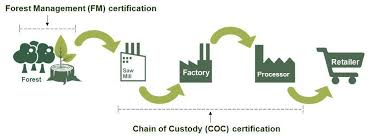Governance
Forest Certification
- 06 Mar 2023
- 4 min read
Prelims: Forest Certification, Deforestation, Climate Change, Forest Stewardship Council.
Mains: Forest Certification and standards.
Why in News?
With climate change, Deforestation has become a critically sensitive issue globally in recent years, making imperative for Forest Certification to regulate the entry and sale of forest-based products.
- At the Glasgow climate meeting in 2021, more than 100 countries made a pledge to stop, and start reversing, deforestation by 2030.
What is Forest Certification?
- Need:
- Forests absorb large amounts of carbon dioxide that is emitted in various economic activities, keeping a check on global warming.
- Many Countries are trying to avoid consumption of any product that might be the result of deforestation or illegal logging.
- And therefore, Europe and the United States have passed laws that regulate the entry and sale of forest-based products in their markets, creating the need for Forest Certification.
- Forest Certification:
- It is a mechanism for forest monitoring, tracing and labelling timber, wood and pulp products and non-timber forest products.
- It is a process through which quality of management from environmental, social and economic perspectives is judged against a series of agreed standards.
- There are two major international standards for sustainable management of forests and forest-based products,
- One has been developed by Forest Stewardship Council (FSC);
- The other by Programme for Endorsement of Forest Certifications (PEFC).
- FSC certification is more popular and in demand, and also more expensive.
- Two Types of Certifications:
- Forest management (FM) and Chain of Custody (CoC).
- CoC certification is meant to guarantee the traceability of a forest product like timber throughout the supply chain from origin to market.
- Forest management (FM) and Chain of Custody (CoC).
- Forest Certification in India:
- The forest certification industry has been operating in India for the last 15 years.
- Currently, forests in only Uttar Pradesh are certified.
- Forty-one divisions of the UP-Forest Corporation (UPFC) are PEFC-certified, meaning they are being managed according to standards endorsed by PEFC.
- Some other states too obtained certifications, but subsequently dropped out.
- Forest certification in India is still at an early stage and therefore the nation has not been able to make use of the benefits of forest certification.
What are India Specific Standards?
- India allows the export of only processed wood, not timber. In fact, the timber harvested from Indian forests is not enough to meet the domestic demand for housing, furniture, and other products.
- India’s forests contribute just about five million cubic metres of wood every year. Almost 85% of the demand for wood and wood products is met by trees outside forests (ToF). About 10 % is imported.
- India’s wood import bill is Rs 50,000-60,000 crore per year.
- Since ToF are so important, new certification standards are being developed for their sustainable management.
- PEFC already has certification for TOF and in 2022, FSC came up with India-specific standards that included certification for ToF.





